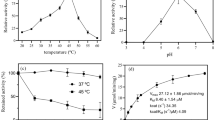Abstract
Pseudomonas aeruginosa synthesizes large quantities of exopolysaccharide (EPS), making it an excellent model organism for the study of EPS-mediated adhesion. The purpose of this investigation was to evaluate the influence of limited nutrients availability in the culture medium on the composition of EPS produced by P. aeruginosa. The relationship between the EPS production and the adhesion process of the P. aeruginosa cells to stainless steel surface (type 316 L) under starvation conditions were also examined. In all experimental variants P. aeruginosa produced more EPS with an increase of incubation period upon starvation conditions. Under limited nutrients condition, glucose dominated in the EPS materials. After 6 days of the process, only glucosyl units were detected in the extracellular matrix produced by nutrient-deprived P. aeruginosa cells. These extracellular molecules promoted more advanced stages of P. aeruginosa biofilm formation on the surface of stainless steel.

Similar content being viewed by others
References
Allison DA, Sutherland IW (1987) The role of exopolysaccharides in adhesion of freshwater bacteria. J Gen Microbiol 133:1319–1327
Bower CK, McGuire J, Daeschel MA (1996) The adhesion and detachment of bacteria and spores on food-contact surfaces. Trends Food Sci Tech 7:152–157
Celik GY, Aslim B, Beyatli Y (2008) Characterization and production of the exopolysaccharide (EPS) from Pseudomonas aeruginosa G1 and Pseudomonas putida G12 strains. Carbohydr Polym 73:178–182
Chen X, Stewart PS (2002) Role of electrostatic interactions in cohesion of bacterial biofilms. Appl Microbiol Biotechnol 59:718–722
Costerton JW, Cheng K-I, Geesey G (1981) Bacterial biofilms in nature and disease. Annu Rev Microbiol 35:399–424
Drenkard E (2003) Antimicrobial resistance of Pserudomonas aeruginosa biofilms. Microbes Infect 5:1213–1219
Dunne WM (2002) Bacterial adhesion: seen any good biofilms lately? Clin Microbiol Rev 15:155–166
Forde A, Fitzgerald GF (1999) Analysis of exopolysaccharide (EPS) production mediated by the bacteriphage adsorption blocking plasmid, pCI658, isolated from Lactococcus lactis ssp. cremoris HO2. Int Dairy J 9:465–472
Friedman L, Kolter R (2004) Genes involved in matrix formation in Pseudomonas aeruginosa PA14 biofilms. Mol Microbiol 51:675–690
Fuster-Valls N, Hernandez-Herrero M, Marin-de-Mateo M et al (2008) Effect of different environmental conditions on the bacteria survival on stainless steel surfaces. Food Control 19:308–314
Gram L, Ravn L, Rasch M et al (2002) Food spoilage––interactions between food spoilage bacteria. Int J Food Microbiol 78:79–97
Grobe S, Wingender J, Flemming H-C (2001) Capability of mucoid Pseudomonas aeruginosa to survive in chlorinated water. Int J Hyg Environ Health 204:139–142
Hung C-C, Santschi PH, Gillow JB (2005) Isolation and characterization of extracellular polysaccharides produced by Pseudomonas fluorescens Biovar II. Carbohydr Polym 61:141–147
Kiliς NK, Dönmez G (2008) Environmental conditions affecting exopolysaccharide production by Pseudomonas aeruginosa, Micrococcus sp., and Ochrobactrum sp. J Hazard Mater 154:1019–1024
Le Thi TT, Prigent-Combaret C, Dorel C et al (2001) First stages of biofilm formation: characterization and quantification of bacterial functions involved in colonization process. Methods Enzymol 336:152–159
Parkar SG, Flint SH, Palmer JS et al (2001) Factors influencing attachment of thermophilic bacilli to stainless steel. J Appl Microbiol 11:675–685
Pontefract RD (1991) Bacterial adherence: its consequences in food processing. Can I Food Sci Tech J 24:113–117
Precival SL, Knapp JS, Edyvean RGJ et al (1998) Biofilms, mains water and stainless steel. Water Res 32:2187–2201
Sanin SL, Sanin SD, Bryers JD (2003) Effect of starvation on the adhesive properties of xenobiotic degrading bacteria. Process Biochem 38:909–914
Schubert R (1989) The use of arginine briliantgreen glucose peptone broth (ABGP medium) as a primary culture medium for Pseudomonas aeruginosa. Zbl Bakt Mik Hyg 187:166–268
Wai SN, Mizunoe Y, Yoshida S (1999) How Vibrio cholerae survive during starvation. FEMS Microbiol Lett 180:123–131
Acknowledgment
This study was supported by the Ministry of Science and Higher Education, Poland, project no NN 312326533.
Author information
Authors and Affiliations
Corresponding author
Rights and permissions
About this article
Cite this article
Myszka, K., Czaczyk, K. Characterization of Adhesive Exopolysaccharide (EPS) Produced by Pseudomonas aeruginosa Under Starvation Conditions. Curr Microbiol 58, 541–546 (2009). https://doi.org/10.1007/s00284-009-9365-3
Received:
Revised:
Accepted:
Published:
Issue Date:
DOI: https://doi.org/10.1007/s00284-009-9365-3




